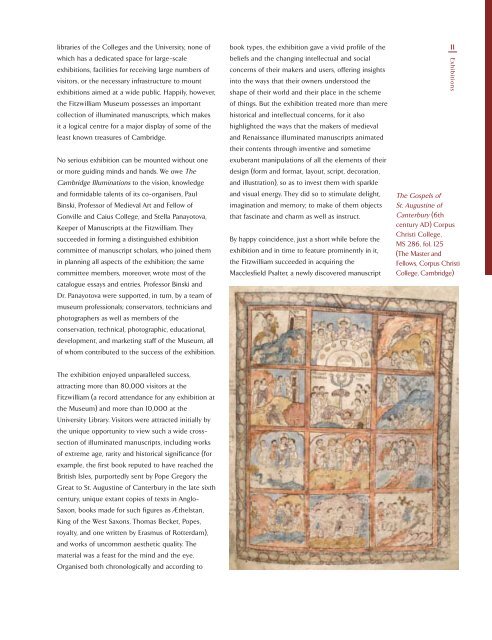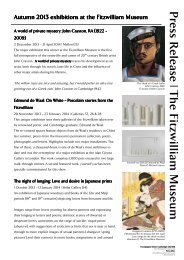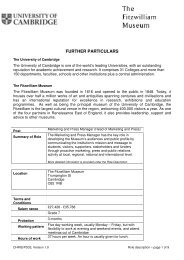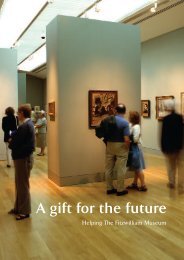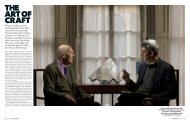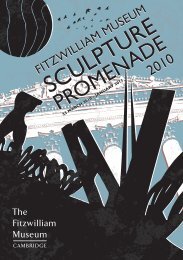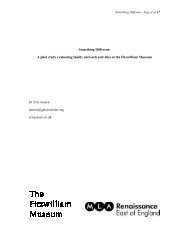The Fitzwilliam Museum - University of Cambridge
The Fitzwilliam Museum - University of Cambridge
The Fitzwilliam Museum - University of Cambridge
Create successful ePaper yourself
Turn your PDF publications into a flip-book with our unique Google optimized e-Paper software.
libraries <strong>of</strong> the Colleges and the <strong>University</strong>, none <strong>of</strong><br />
which has a dedicated space for large-scale<br />
exhibitions, facilities for receiving large numbers <strong>of</strong><br />
visitors, or the necessary infrastructure to mount<br />
exhibitions aimed at a wide public. Happily, however,<br />
the <strong>Fitzwilliam</strong> <strong>Museum</strong> possesses an important<br />
collection <strong>of</strong> illuminated manuscripts, which makes<br />
it a logical centre for a major display <strong>of</strong> some <strong>of</strong> the<br />
least known treasures <strong>of</strong> <strong>Cambridge</strong>.<br />
No serious exhibition can be mounted without one<br />
or more guiding minds and hands. We owe <strong>The</strong><br />
<strong>Cambridge</strong> Illuminations to the vision, knowledge<br />
and formidable talents <strong>of</strong> its co-organisers, Paul<br />
Binski, Pr<strong>of</strong>essor <strong>of</strong> Medieval Art and Fellow <strong>of</strong><br />
Gonville and Caius College, and Stella Panayotova,<br />
Keeper <strong>of</strong> Manuscripts at the <strong>Fitzwilliam</strong>. <strong>The</strong>y<br />
succeeded in forming a distinguished exhibition<br />
committee <strong>of</strong> manuscript scholars, who joined them<br />
in planning all aspects <strong>of</strong> the exhibition; the same<br />
committee members, moreover, wrote most <strong>of</strong> the<br />
catalogue essays and entries. Pr<strong>of</strong>essor Binski and<br />
Dr. Panayotova were supported, in turn, by a team <strong>of</strong><br />
museum pr<strong>of</strong>essionals; conservators, technicians and<br />
photographers as well as members <strong>of</strong> the<br />
conservation, technical, photographic, educational,<br />
development, and marketing staff <strong>of</strong> the <strong>Museum</strong>, all<br />
<strong>of</strong> whom contributed to the success <strong>of</strong> the exhibition.<br />
<strong>The</strong> exhibition enjoyed unparalleled success,<br />
attracting more than 80,000 visitors at the<br />
<strong>Fitzwilliam</strong> (a record attendance for any exhibition at<br />
the <strong>Museum</strong>) and more than 10,000 at the<br />
<strong>University</strong> Library. Visitors were attracted initially by<br />
the unique opportunity to view such a wide crosssection<br />
<strong>of</strong> illuminated manuscripts, including works<br />
<strong>of</strong> extreme age, rarity and historical significance (for<br />
example, the first book reputed to have reached the<br />
British Isles, purportedly sent by Pope Gregory the<br />
Great to St. Augustine <strong>of</strong> Canterbury in the late sixth<br />
century, unique extant copies <strong>of</strong> texts in Anglo-<br />
Saxon, books made for such figures as Æthelstan,<br />
King <strong>of</strong> the West Saxons, Thomas Becket, Popes,<br />
royalty, and one written by Erasmus <strong>of</strong> Rotterdam),<br />
and works <strong>of</strong> uncommon aesthetic quality. <strong>The</strong><br />
material was a feast for the mind and the eye.<br />
Organised both chronologically and according to<br />
book types, the exhibition gave a vivid pr<strong>of</strong>ile <strong>of</strong> the<br />
beliefs and the changing intellectual and social<br />
concerns <strong>of</strong> their makers and users, <strong>of</strong>fering insights<br />
into the ways that their owners understood the<br />
shape <strong>of</strong> their world and their place in the scheme<br />
<strong>of</strong> things. But the exhibition treated more than mere<br />
historical and intellectual concerns, for it also<br />
highlighted the ways that the makers <strong>of</strong> medieval<br />
and Renaissance illuminated manuscripts animated<br />
their contents through inventive and sometime<br />
exuberant manipulations <strong>of</strong> all the elements <strong>of</strong> their<br />
design (form and format, layout, script, decoration,<br />
and illustration), so as to invest them with sparkle<br />
and visual energy. <strong>The</strong>y did so to stimulate delight,<br />
imagination and memory; to make <strong>of</strong> them objects<br />
that fascinate and charm as well as instruct.<br />
By happy coincidence, just a short while before the<br />
exhibition and in time to feature prominently in it,<br />
the <strong>Fitzwilliam</strong> succeeded in acquiring the<br />
Macclesfield Psalter, a newly discovered manuscript<br />
11<br />
Exhibitions<br />
<strong>The</strong> Gospels <strong>of</strong><br />
St. Augustine <strong>of</strong><br />
Canterbury (6th<br />
century AD) Corpus<br />
Christi College,<br />
MS 286, fol. 125<br />
(<strong>The</strong> Master and<br />
Fellows, Corpus Christi<br />
College, <strong>Cambridge</strong>)


